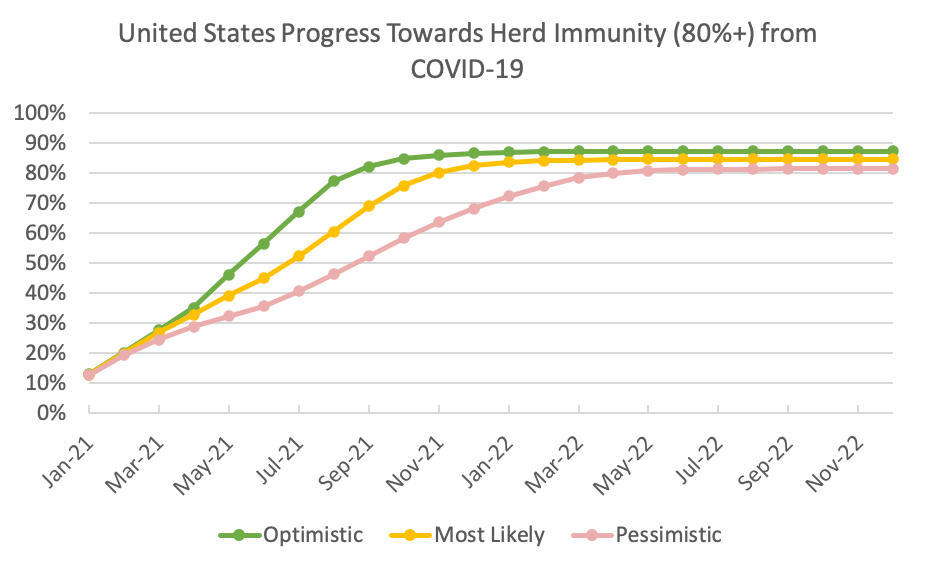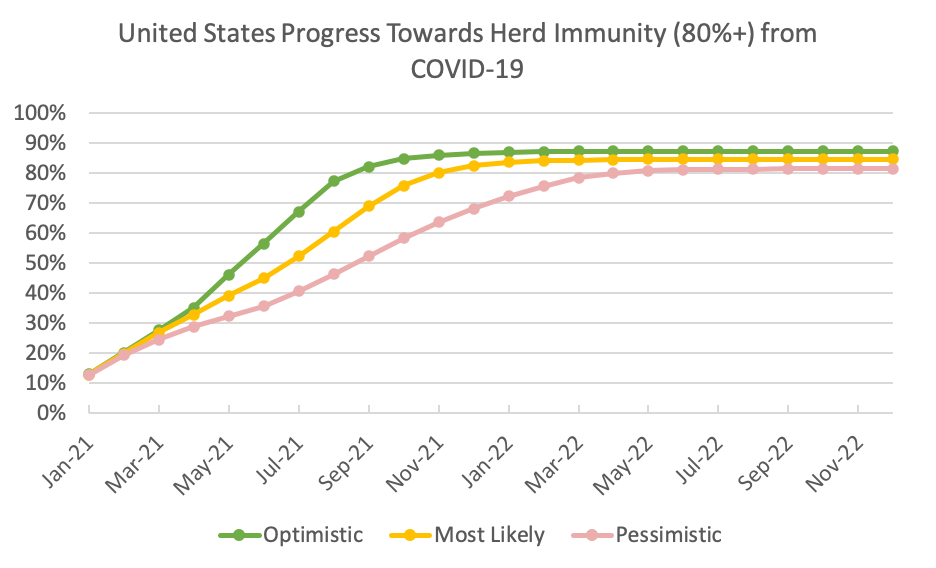Economic Update: Herd Immunity from COVID-19

By Chris Chmura |
This article was originally published in the Richmond Times Dispatch on February 8, 2021.
Economists typically create forecasts based on assumptions such as how much the Federal Reserve will change the federal funds rate target or changes in the price of oil or the unemployment rate. Although those factors remain important, a more important driver of economic activity in 2021 is when the nation will reach herd immunity from COVID-19.
Many medical experts agree that about 80% of the population will need to be immune to the virus to reach herd immunity, either through vaccination or by previously contracting the virus. When we do get to herd immunity, consumers and businesses will presumably start to behave more like they did prior to the pandemic.
So when will we get there?
As of February 1, 2021, over 26 million Americans (7.9%) have received their first dose of the Pfizer or Moderna vaccine, including nearly 6 million who have also received their second dose that is needed to reach maximum efficacy. During the week of January 25, an average of over 1 million doses were administered per day.
Using vaccination rates from the Centers for Disease Control and Prevention (CDC), estimated infection counts from the University of Washington, vaccine allotment announcements, and information regarding vaccination rate ramp-up from President Biden, Dr. Fauci, and other medical experts, Chmura built a herd immunity timeline model with three scenarios.

In the optimistic scenario, we assume the vaccination rate in the United States slightly exceeds President Biden’s 100-day goal of 100 million Americans receiving their first dose. In this scenario, vaccination rates scale up to 3 million total doses per day in May 2021 as problems arising from vaccine distribution and administration are quickly resolved. After somewhat tapering off as the non-vaccinated population becomes more difficult to reach, over 80% of the U.S. population is fully vaccinated by September 2021.
In the most-likely scenario, we assume 88 million Americans receive their first dose of the COVID-19 vaccine by the end of President Biden’s first 100 days. Supply chain disruptions and difficult-to-reach populations constrain vaccine administration to a peak of only 2 million total (first and second) total doses administered per day. In this scenario, the nation fully vaccinates over 80% of its population by the end of November 2021.
In the pessimistic scenario, we assume only 67 million Americans receive their first dose of the COVID-19 vaccine by the end of President Biden’s first 100 days. Significant supply chain disruptions and slower vaccine acceptance caps the average number of vaccine doses administered per day at 1.5 million. In this scenario, the nation does not fully vaccinate over 80% of Americans until April 2022.
All of these scenarios assume that the efficacy of current vaccines remains high with new variants of the virus.

Like many economists, we will be monitoring vaccination rates closely. Our most-likely scenario points to a strong economy in 2021, but weaker growth after the COVID-related stimulus works its way through the economy in the years following 2021.
At this point, vaccine dosage administration rates vary greatly by state, with Alaska leading the way with 13.6% of its population having received their first vaccine dose as of February 4, followed by West Virginia (11.0%), New Mexico (10.7%), and Connecticut (10.5%) based on CDC and Census data.
Virginia ranks 10th among all states, with 9.1% of the population having received their first vaccine dose.
At this rate, the state could reach herd immunity by November 2021 in the most-likely scenario—about the same timeline as the nation. Under the optimistic scenario, both the state and nation reach herd immunity in November.
Further details and updates about this model can be found at https://www.chmura.com/blog/when-will-we-reach-herd-immunity-from-covid-19.
Subscribe to the Weekly Economic Update
Subscribe to the Weekly Economic Update and get news delivered straight to your inbox.







